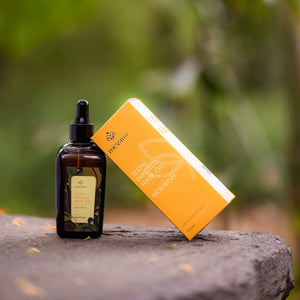Is your hair falling out faster than your patience can keep up? You're not alone. Every day, a whopping 35 million men and 21 million women worldwide go through the tough deal of losing their hair! The statistics may seem cold, but the emotional toll is nothing short of devastating. But here's the silver lining: what if I tell you that you don't need a hair care overhaul, just small changes that can make a big impact?
What if tackling hair fall is possible without turning your life upside down? What if I take you through a routine where your hair stays put, and you don't have to sacrifice your favorite habits? That's what we're aiming for. And I am not talking about any major disruptions – just simple tweaks to your routine that won't disrupt your groove.
And here's the best part: no pills, no potions. Just routine and external practices that complement any internal routines you already have. Whether you're sipping a magic hair potion or not, these steps won't disrupt your inner equilibrium; that's a bet!
But Will These External Therapies Work?
Now, you might wonder: can simple changes to your routine and external practices make a difference in the battle against extreme hair fall? It's a fair question.
Let's cut through the noise. Ayurveda, the ancient science of healing, describes two types of therapies for managing any disease – Antah Parimarjan Chikitsa (Internal Therapies) and Bahya Parimarjan Chikitsa (External Therapies). For a treatment regimen to be effective, both are necessary. The same holds true for the challenge of hair fall.
These external aids, which we are about to explore, fall into the category of Bahya Parimarjan Chikitsa. So, do they work? Yes, but they require commitment and time. The journey to healthier hair is a marathon, not a sprint. Let's start looking into things to add to your routine that'll have your locks thanking you.
What Are Those Therapies and Routines?
Now that we've clarified that external therapies play a vital role in combating extreme hair loss, let's dive into the specifics of those self-doable Ayurvedic practices to include in your routine to enhance your hair's health from the inside out.
Head Massage (Shiro Abhyanga)
When it comes to healthy hair, nothing can beat Shiro Abhyanga massages. This not only enhances blood circulation but also nourishes the hair follicles, promoting healthier and stronger hair.
So, what's the right way to include head massages in your routine?

Vata Folks:
Dry and frizzy hair is often the main concern for Vatas, which is why;
- Opt for warm, nourishing oil blends with a Sesame oil base like Bhringraj Oil.
- Keep the oil on the head for at least 5 to 6 hours or overnight.
- Perform this ritual 2-3 times weekly, especially during the colder months.
Pitta Folks:
Pittas have a fiery disposition also leading to hair fall and premature graying, so cooling and calming head abhyanga is a go-to for them.
- Choose a Ghee or coconut oil base or a cooling herbal oil like Brahmi.
- Keep the oil on the head for about 3 hours to 4 hours.
- Perform this ritual 1-2 times a week, especially during warmer seasons when Pitta aggravates.
Kapha Folks:
Kaphas are already prone to excess oiliness and stagnation, requiring a balanced head abhyanga.
- Massage with warm mustard oil, sunflower oil, olive oil, or Amla oil.
- Keep the oil on the head for around 30 minutes to 2 hours.
- Perform the head abhyanga 2-3 times a week, especially during winter.
Head Lepa Masks
What if I tell you that your simple kitchen ingredients and goodness of herbs can bring you a spa-like hair experience? The head lepa masks work wonders in reviving your locks, providing essential nutrients and hydration.
So, how do you make a well-crafted hair mask that holds the power to breathe life into your tresses?

Whisk, blend, and apply from root to length to clean hair. Let it sit for an hour or two, then wash off with a gentle cleanser.
- Vatas should focus on hydrating and nourishing herbs like Bhringraj and Shatavari. Blend with bananas, milk, eggs, and oils to counteract dryness and promote hair strength.
- Pitta individuals may lean towards cooling and soothing herbs like Amla and Brahmi. Blend with Aloe or coconut pulp to balance excess heat and maintain a healthy scalp.
- Kapha individuals may seek invigorating and stimulating herbs like Triphala and Jatamansi. Blend with water or curd to address excess oiliness and promote hair volume.
Kashaya Rinses for Hair
What else can provide a refreshing boost to your hair care regimen? Kashaya Rinses! Because they cleanse your hair and add a lustrous shine to your precious locks!
So, how do you infuse the goodness of Kashaya rinses into your routine?

Ingredients:
- 3-4 cups of water
- 1-2 tablespoons of dried herbs
- Vatas – Hibiscus, Rice, Fenugreek, Aloe vera, Bhringraj
- Pittas – Rose, Chandan, Brahmi, Amla, Shikakai
- Kaphas – Tea, Triphala, Rosemary, Jatamansi.
Instructions:
- Boil water and add dried herbs.
- Simmer for 15-20 minutes.
- Let it reduce by one-third.
- Strain the herbal infusion.
- Let it cool to a comfortable temperature.
- After shampooing, pour the herbal rinse over your hair.
- Massage into your scalp and leave for a minute.
- Rinse with cool water.
Nasya
Next, we have Nasya, a star Ayurvedic practice of instilling oil in your nose. Wondering how pouring oil can help with hair woes? Your nose cavity is a gateway to the brain and home to vital blood vessels nourishing your head and scalp. So, when oil is poured into your nose, it calms your aggravated Doshas, reduces stress, clears your sinuses, and helps with the blood circulation of the vessels connecting to your scalp! It is like one sure-shot remedy for managing all these triggers associated with hair fall. All you need to do is pour a drop or two of Nasya oils like Anu Thailam, Ghee, or Almond oil into your nostrils before bed, and voila, let the magic unfold!

Now you finally know what works. However, it's essential to set realistic expectations. Patience is key, and consistency is your ally. Rome wasn't built in a day, and your hair will transform over time. You'll see the magic happen by sticking to these external therapies over time.
It's also important to note that these external practices aren't meant to replace any ongoing medical treatments or internal remedies you might be using. Instead, consider them supportive allies, working with your existing hair care routines.






